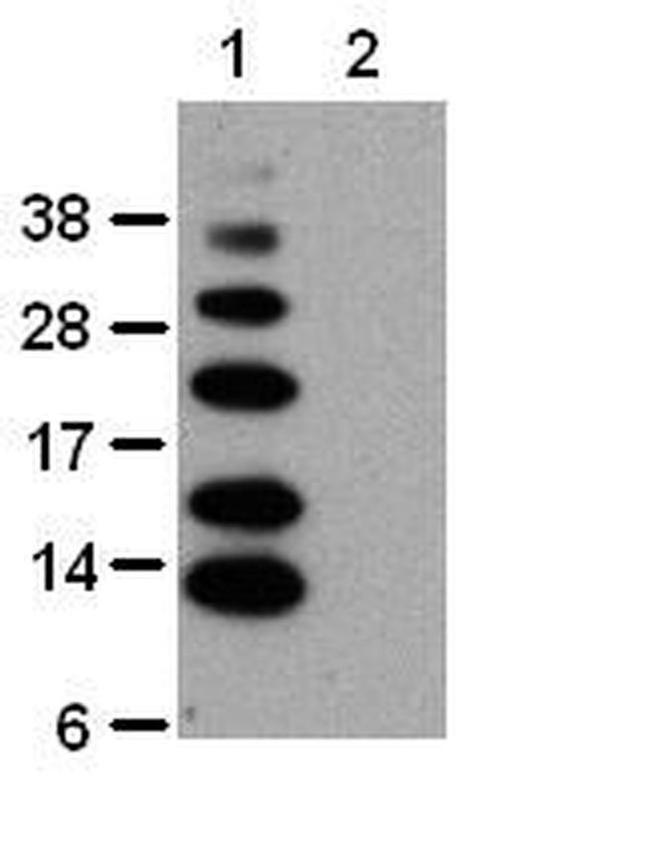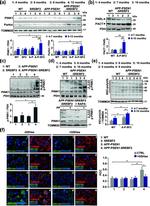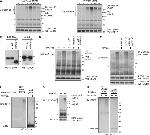Search Thermo Fisher Scientific
Invitrogen
Ub-K63 Monoclonal Antibody (HWA4C4), eBioscience™
Product Details
14-6077-82
Species Reactivity
Published species
Host/Isotype
Class
Type
Clone
Conjugate
Form
Concentration
Purification
Storage buffer
Contains
Storage conditions
Shipping conditions
RRID
Product Specific Information
Description: Ubiquitin is a highly conserved 76kDa protein which is ligated to many proteins in both monomeric and polymeric forms. Ubiquitin polymers (polyubiquitin) can be found in several varieties depending on which of its 7 lysine residues is the site of ligation. The two most common polymer chains are linked via an isopeptide bond between glycine-76 and either lysine-48 (K-48) or lysine-63 (K-63). K-48-linked polyubiquitination typically results in targeting the protein to the 26S proteosome resulting in proteolysis, although recently exceptions to this have been observed. In contrast, K-63-linked polyubiquitination results in signals related to intracellular trafficking, cell signaling, ribosomal biogenesis, and DNA damage repair. There are also reports that K63-linked polyubiquitin is involved in proteosome-independent proteolysis via autophagy.
HWA4C4 reacts specifically with the isopeptide linkage region of lysine-63-linked polyubiquitin. It does not react with other forms of ubiquitin including ubiquitin monomer and lysine-48-linked chains.
Applications Reported: This HWA4C4 antibody has been reported for use in immunoblotting (WB).
Applications Tested: This HWA2-8°C4 antibody has been tested by immunoblot of lysine-63-linked polyubiquitin chains. This can be used at less than or equal to 2 µg/mL. It is recommended that the antibody be carefully titrated for optimal performance in the assay of interest.
Purity: Greater than 90%, as determined by SDS-PAGE.
Aggregation: Less than 10%, as determined by HPLC.
Filtration: 0.2 µm post-manufacturing filtered.
Target Information
Ubiquitin is a conserved 76 amino acid polypeptide and can affect proteasomal degradation of the protein it is bound to, or mediate interactions with other proteins related to post-translational modifications. The degradation of cellular regulatory proteins by the Uubiquitin pathway is important as it controls the cellular growth and proliferation. Ubiquitin-dependent proteolysis occurs after a covalent attachment of the peptide to a lysine residue of a protein, which involves three enzymatic reactions: E1, E2 and E3. The first reaction involves ubiquitin-activating enzyme. The third reaction uses enzyme ubiquitin ligase (E3) to transfer the activated ubiquitin from E2 to a lysine residue on a protein, or directly transfers the ubiquitin from E2 to the substrate.
For Research Use Only. Not for use in diagnostic procedures. Not for resale without express authorization.
Bioinformatics
Protein Aliases: 40S ribosomal protein S27a; CEP52; epididymis luminal protein 112; epididymis secretory protein Li 50; polyubiquitin B; Polyubiquitin-B; Polyubiquitin-C; Ubiquitin A-52 residue ribosomal protein fusion product 1; ubiquitin and ribosomal protein S27a; ubiquitin C; ubiquitin carboxyl extension protein 52; Ubiquitin carboxyl extension protein 80; ubiquitin-52 amino acid fusion protein; ubiquitin-CEP52; ubiquitin-CEP80; Ubiquitin-ribosomal protein eL40 fusion protein; Ubiquitin-ribosomal protein eS31 fusion protein
Gene Aliases: CEP52; CEP80; HEL-S-50; HEL112; HMG20; HUBCEP52; L40; RPL40; RPS27A; S27A; UBA52; UBA80; UBB; UBC; UBCEP1; UBCEP2; UBCEP80
UniProt ID: (Human) P62979, (Human) P62987, (Human) P0CG47, (Human) P0CG48
Entrez Gene ID: (Human) 6233, (Human) 7311, (Human) 7314, (Human) 7316

Performance Guarantee
If an Invitrogen™ antibody doesn't perform as described on our website or datasheet,we'll replace the product at no cost to you, or provide you with a credit for a future purchase.*
Learn more
We're here to help
Get expert recommendations for common problems or connect directly with an on staff expert for technical assistance related to applications, equipment and general product use.
Contact tech support



